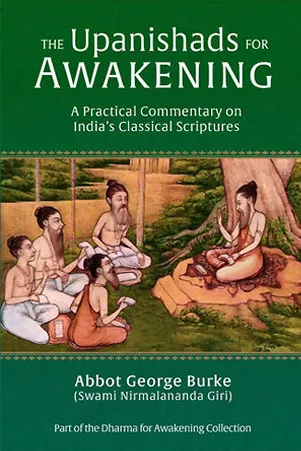
“Both the individual self and the Universal Self have entered the cave of the heart, the abode of the Most High, but the knowers of Brahman and the householders who perform the fire sacrifices see a difference between them as between sunshine and shadow” (Katha Upanishad 1:3:1)
The two selves
There are two kinds of selves–the many individual selves and the one Universal Self. The Mundaka Upanishad likens them to two birds of the same appearance who sit in the same tree. “Like two birds of golden plumage, inseparable companions, the individual self and the immortal Self are perched on the branches of the selfsame tree. The former tastes of the sweet and bitter fruits of the tree; the latter, tasting of neither, calmly observes” (Mundaka Upanishad 3.1.1). First we come to know the individual Self, and that enables us to attain the knowledge of the All-inclusive Self. How the two exist as one yet two is incomprehensible to the intellect but is readily experienced by the inmost consciousness of the persevering yogi. Yet intellectually we need to have some grasp of the unity/duality, otherwise we can have no correct perspective on anything, inner or outer. Extreme dualism is an error, and “monism” of any kind is even worse in its “simplisticism.” For this reason the enlightened use the expression Non-Dual (advaita) as the nearest we can come to conveying the truth of our existence. The verse beginning Purnamadah purnamidam is usually interpreted as a statement that the Relative has come from the Transcendent while retaining essential unity with the Transcendent. But it can also be understood as referring to the individual Self that exists rooted in the Universal Self. It, the atman, originates in the Supreme Self, the Paramatman, and is never separate from that Self. If examined, the two will be seen to be one. How is it possible? The One alone knows–and those who have united their consciousness with the One through yoga.
The cave of the heart
It is easy to see that the individual Self abides in–and as–the heart (hridaya), but when we look at the vast manifestation of Cosmic Life that is the creation it is natural for our awareness to be drawn outward and thereby forget that the Supreme Self is right there inside in the same space (akasha). The Paramatman is not in the cave of our heart only incidentally, since It is everywhere, but that is Its abode, its “native place,” Its center. Its manifestation can be found everywhere, but It can be found only in the cave of the heart.
“Only that yogi whose joy is inward, inward his peace, and his vision inward shall come to Brahman and know Nirvana” (Bhagavad Gita 5:24)
“Great is that yogi who seeks to be with Brahman, greater than those who mortify the body, greater than the learned, greater than the doers of good works: therefore, Arjuna, become a yogi” (Bhagavad Gita 6:46)
How foolish to climb mountains, delve into the earth, wander across the plains, or cross the seas, thinking to find the Abode of God–which is the heart alone.
The two knowers
There are those who know Brahman directly and those who possess a secondary knowledge based on intuition resulting from their seeking of Brahman. Though only the first really know Brahman, yet the others’ knowing about Brahman is of such a character that it can lead them on to the direct knowledge of the illumined. Both of these have the same understanding without contradiction. Therefore the Finders never disdain the Seekers.
The difference
What do the Finders and Seekers know? That the atman and the Paramatman, though one, are as different as sunshine and shadow. But not in the sense of being opposite or antithetical to one another. Rather, it means that the individual Self exists only because the Supreme Self exists, just as a shadow can only exist because of the light. As the Rig Veda says of the Supreme Self: “His shadow is immortality.” Also, the idea is that the individual Self (jivatman) is a reflection of the Supreme Self (Paramatman). Later, Yama will say: “He shining, everything shines” (Katha Upanishad 2:2:15)
The aspiration
Since the foregoing is true, the next verse of the upanishad says: “May we perform the Nachiketa Sacrifice, which bridges the world of suffering. May we know the imperishable Brahman, who is fearless, and who is the end and refuge of those who seek liberation” (Katha Upanishad 1:3:2)
What is the Nachiketa Sacrifice? It is not a secret fire ritual that produces a magical enlightenment. The Nachiketa Sacrifice is the determined search for knowledge (jnana) which stops not until the Goal is reached. That this is the correct understanding is demonstrated by the results desired by the sacrificer: the knowledge of Brahman.
The search for union with God is the bridge which we cross to be free from this world of suffering. Seeking God is itself the guarantee that we shall find Him. Many who lack confidence worry as to whether they can succeed in spiritual life, if they are “ready,” and so forth. But the very fact that they wish to find God means that they have already travelled far along the path in previous lives. Otherwise they would sleep along with most of the world. “For the man who has once asked the way to Brahman goes further than any mere fulfiller of the Vedic rituals” (Bhagavad Gita 6:44). “The scriptures declare that merit can be acquired by studying the Vedas, performing ritualistic sacrifices, practicing austerities and giving alms. But the yogi who has understood this teaching of mine will gain more than any who do these things. He will reach that universal source, which is the uttermost abode of God” (Bhagavad Gita 8:28)
Truly, “May we know the imperishable Brahman, who is fearless, and who is the end and refuge of those who seek liberation.”
Read the next article in the Upanishads for Awakening: The Chariot







